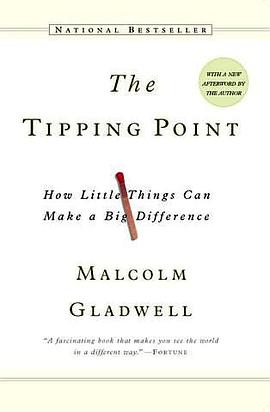

具體描述
"The best way to understand the dramatic transformation of unknown books into bestsellers, or the rise of teenage smoking, or the phenomena of word of mouth or any number of the other mysterious changes that mark everyday life," writes Malcolm Gladwell, "is to think of them as epidemics. Ideas and products and messages and behaviors spread just like viruses do." Although anyone familiar with the theory of memetics will recognize this concept, Gladwell's The Tipping Point has quite a few interesting twists on the subject.
For example, Paul Revere was able to galvanize the forces of resistance so effectively in part because he was what Gladwell calls a "Connector": he knew just about everybody, particularly the revolutionary leaders in each of the towns that he rode through. But Revere "wasn't just the man with the biggest Rolodex in colonial Boston," he was also a "Maven" who gathered extensive information about the British. He knew what was going on and he knew exactly whom to tell. The phenomenon continues to this day--think of how often you've received information in an e-mail message that had been forwarded at least half a dozen times before reaching you.
Gladwell develops these and other concepts (such as the "stickiness" of ideas or the effect of population size on information dispersal) through simple, clear explanations and entertainingly illustrative anecdotes, such as comparing the pedagogical methods of Sesame Street and Blue's Clues, or explaining why it would be even easier to play Six Degrees of Kevin Bacon with the actor Rod Steiger. Although some readers may find the transitional passages between chapters hold their hands a little too tightly, and Gladwell's closing invocation of the possibilities of social engineering sketchy, even chilling, The Tipping Point is one of the most effective books on science for a general audience in ages. It seems inevitable that "tipping point," like "future shock" or "chaos theory," will soon become one of those ideas that everybody knows--or at least knows by name. --Ron Hogan, Amazon.com
著者簡介
Malcolm Gladwell is a former business and science writer at the Washington Post. He is currently a staff writer for The New Yorker.
圖書目錄
讀後感
1.流行三要素:传播行为、传播物本身、传播物发挥作用的环境。 2.个别人物法则(Law of the Few):三种关键角色联系员、内行、销售员。联系员维系着大规模的弱联系,是小世界中的社交经纪,他们不会回避对于社交关系的义务,在维持简单、随意、广泛的社交中获得快乐;内行会主...
評分《引爆流行》中的“个别人物法则”、“附着力因素法则”、“环境威力法则”很好地解释了流行潮发生的原因。 我尝试着用这三个法则分析了一下“超女”的流行: 个别人物法则:通过组织“超女”们的fans,使“超女”成为联系员。 附着力因素法则(事物传递的信息):用PK、女...
評分一种流行病的爆发需要三个条件,人们传播传染物的行为、传染物本身和传染物发挥作用需要的环境。一个流行潮的爆发,也起因于类似的三个条件,作者称之为个别人物法则、附着力因素、环境威力法则,其中任何一个条件的变化都可能引爆一场流行。 个别人物法则指出,一些特殊的人,...
評分翻译的太不怎么样了!简直惨不忍睹! 钱清还是北大教翻译的,真实难以置信。是让学生翻的吧? 比如第一页第六句,People were going to the Ma and Pa stores, the little stores that still carried them, and buying them up. Ma and Pa ...
評分最近韩国的都教授和长腿哥让国内的女粉丝尖叫不已,也让国内的汉子们相当的不服气!咱腿也不短脸也不黑,为啥让俩韩国棒子在咱地盘肆虐捕获无数妹子呢?今天我们就来讨论一下流行的现象,是什么导致事物流行? 其实流行的概念大到时尚、文化传媒和商业界,小到圈子里...
用戶評價
沒有Outliers好,有些例子比較牽強,觀點的清晰度也弱一些。
评分隻用幾句話的書何必寫成一本書
评分完全名過其實的一本書。全書可以用一頁講完:流行靠關鍵節點、感染力以及具體環境。然而作者靠車軲轆話翻來覆去(注意瞭這人是來事的關鍵,上節咱們說瞭這人很關鍵,都聽好瞭要來事就得跟上上章的這人學!),堆砌許多不相關的案例(有些和epidemics根本沒關係),能拉長到一本書。這書本質上是市場營銷書,以稀釋過的社會學和心理學為賣點。就像培訓師一樣,案例越多越好,重復越多次越好,正說反說掰碎瞭說,抖個機靈賣個新鮮,而讀者大可不必深入思考。這種文風適閤公開演講,適閤去TED,不適閤寫書。在聽這本書之前,我剛聽瞭另一本暢銷書Freakonomics。兩本書都以通俗社會科學作為主題,都談到紐約90年代犯罪率反常下降、父母對子女後天影響其實有限等話題,相比較本書的解釋分析就要淺嘗輒止得多。
评分感覺這本書提齣的理論怎麼套事實都可以...沒有驗證,因為驗證本身就undoable.
评分淺顯易讀,非小說類暢銷書典範。
相關圖書
本站所有內容均為互聯網搜索引擎提供的公開搜索信息,本站不存儲任何數據與內容,任何內容與數據均與本站無關,如有需要請聯繫相關搜索引擎包括但不限於百度,google,bing,sogou 等
© 2025 book.quotespace.org All Rights Reserved. 小美書屋 版权所有




















